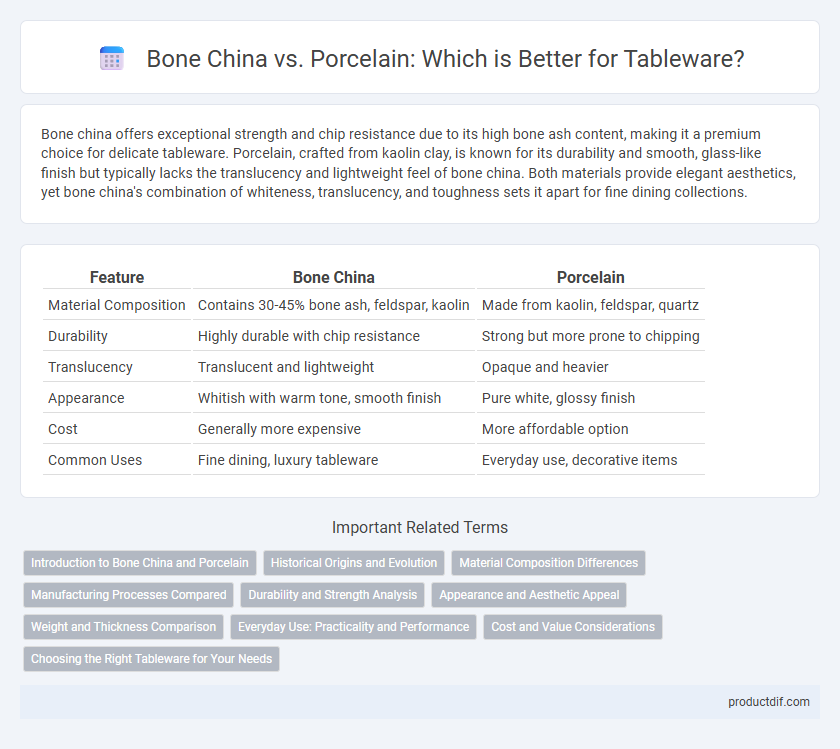Bone china offers exceptional strength and chip resistance due to its high bone ash content, making it a premium choice for delicate tableware. Porcelain, crafted from kaolin clay, is known for its durability and smooth, glass-like finish but typically lacks the translucency and lightweight feel of bone china. Both materials provide elegant aesthetics, yet bone china's combination of whiteness, translucency, and toughness sets it apart for fine dining collections.
Table of Comparison
| Feature | Bone China | Porcelain |
|---|---|---|
| Material Composition | Contains 30-45% bone ash, feldspar, kaolin | Made from kaolin, feldspar, quartz |
| Durability | Highly durable with chip resistance | Strong but more prone to chipping |
| Translucency | Translucent and lightweight | Opaque and heavier |
| Appearance | Whitish with warm tone, smooth finish | Pure white, glossy finish |
| Cost | Generally more expensive | More affordable option |
| Common Uses | Fine dining, luxury tableware | Everyday use, decorative items |
Introduction to Bone China and Porcelain
Bone china is a type of porcelain that contains bone ash, feldspar, and kaolin, renowned for its high whiteness, translucency, and exceptional strength compared to traditional porcelain. Porcelain, made primarily from kaolin clay and fired at high temperatures, is valued for its durability, smooth surface, and rich glaze finish. Both materials serve as premium tableware choices, with bone china offering enhanced chip resistance and a lighter, more delicate feel.
Historical Origins and Evolution
Bone china originated in 18th-century England, developed by combining bone ash with porcelain clay to enhance strength and translucency, distinguishing it from traditional porcelain made in China centuries earlier. Porcelain's evolution traces back to the Tang Dynasty (618-907 AD) with its refinement during the Song Dynasty, becoming a symbol of luxury and artistic achievement. Bone china quickly gained popularity in Europe for its durability and delicate appearance, influencing modern tableware design and production techniques.
Material Composition Differences
Bone china contains a significant proportion of bone ash, typically around 30-45%, combined with kaolin and feldspar, giving it a distinct translucency and high strength. Porcelain is primarily made from kaolin clay, quartz, and feldspar without any bone content, resulting in a denser, less translucent material. The presence of bone ash in bone china contributes to its lightweight, chip-resistant quality compared to the harder but more brittle porcelain.
Manufacturing Processes Compared
Bone china is produced by mixing bone ash, feldspar, and kaolin, then firing at lower temperatures around 1,200degC, resulting in a translucent, lightweight, and strong tableware. Porcelain is made primarily from kaolin and fired at higher temperatures between 1,200degC to 1,400degC, which creates a denser, more vitrified finish with less translucency. The inclusion of bone ash in bone china enhances its whiteness and chip resistance, differentiating it from the more durable but less delicate porcelain.
Durability and Strength Analysis
Bone china exhibits superior durability and strength due to its high bone ash content, making it more resistant to chipping and breaking compared to traditional porcelain. Porcelain, while strong and dense, tends to be more brittle under impact stress due to its lower bone ash composition. The advanced firing process of bone china enhances its vitrification, resulting in a lightweight yet highly resilient tableware option ideal for everyday use.
Appearance and Aesthetic Appeal
Bone china features a translucent, milky-white appearance with a smooth, glossy finish that exudes elegance and luxury. Porcelain offers a more opaque, often whiter surface with a slightly thicker and sturdier feel, enhancing durability while maintaining refined aesthetics. Both materials showcase intricate designs, but bone china's delicate translucency gives it a distinctive brightness and softness attractive to collectors and fine dining settings.
Weight and Thickness Comparison
Bone china is generally lighter and thinner than porcelain, offering a delicate yet durable option for fine dining. Porcelain tends to be thicker and heavier, providing increased strength but a more substantial feel. This weight and thickness difference impacts not only aesthetics but also the overall handling and care requirements of each material.
Everyday Use: Practicality and Performance
Bone china offers exceptional durability and chip resistance, making it ideal for everyday use and frequent handling in busy households. Its lightweight nature and elegant translucency do not compromise strength, outperforming traditional porcelain in toughness. Porcelain, while robust and heat-retentive, tends to be heavier and more prone to chipping, which can affect long-term practicality in daily dining settings.
Cost and Value Considerations
Bone china generally commands a higher price than porcelain due to its composition of bone ash, which enhances strength and translucency while increasing production costs. Porcelain offers a more affordable option with durable qualities, making it suitable for everyday use without sacrificing elegance. When evaluating cost versus value, bone china is ideal for formal settings and collectors seeking premium aesthetics, whereas porcelain delivers practical durability at a lower investment.
Choosing the Right Tableware for Your Needs
Bone china offers superior durability and a translucent, elegant appearance, making it ideal for formal dining and everyday use. Porcelain is denser and more resistant to chipping, suited for casual and outdoor settings where sturdiness is prioritized. Selecting between bone china and porcelain depends on your need for refinement versus resilience in tableware.
Bone China vs Porcelain Infographic

 productdif.com
productdif.com